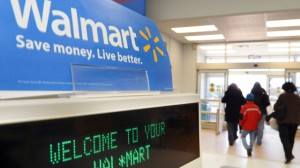
Wal-Mart in Danvers, Massachusetts. A new report shows that the retailer exploits a "performance pay" loophole saving it $104 million in corporate taxes. (Photo by Lisa Poole/AP)
This post first appeared on TooMuch.org.
Back in 1979, notes a new Economic Policy Institute report released last week, households in America’s statistical middle — the 20 percent of households making more than the nation’s poorest 40 percent and less than the nation’s most affluent 40 percent — averaged $16.72, after inflation, per hour worked. In 2012, households in this same statistical middle averaged $16.26 per hour.
Over roughly that same period, EPI analysts add, America’s top one percent of income-earners doubled their share of the nation’s income from paychecks, dividends, rent and business earnings, from 7.2 to 14.2 percent.
Wage stagnation for average Americans; record-level “success” for the one percent. The two have marched hand-in-hand for over three decades now, as EPI’s new Raising America’s Pay paper and two other new studies released last week detail with no small statistical panache.
The new EPI study emphasizes how the failure of wages to grow over recent decades has been driving growing inequality, undermining the living standards of America’s “broad middle class” and stalling all progress against poverty.
Apologists for our current economic order blame wage stagnation on technological change — or workers themselves. Workers don’t have the right skills and credentials to get ahead, their argument goes.
EPI’s Raising America’s Pay picks apart these bogus rationales and shifts the focus to business practices and policies that systematically shift income upward.
Corporate leaders, for instance, routinely stiff workers on overtime and misclassify many others as “independent contractors” to avoid paying benefits. Corporate muscle, meanwhile, keeps minimum wages low and unions weak.
All these moves add billions to corporate bottom lines and inflate the “metrics” — like share price — that corporate boards use to rate how well top corporate executives are “performing.”
But share prices can be capricious. They often rise and fall without much rhyme or reason. CEOs don’t particularly care for this share price uncertainty, and that brings us to the second of last week’s perceptive new studies, a Roosevelt Institute paper that explores just how far top execs will go to artificially rig higher share prices — and how much economic damage this rigging can wreak.
Corporations have been shelling out fabulous sums, Roosevelt Institute author William Lazonick relates, to “buy back” their own shares of stock off the open market, an exercise designed solely to jack up demand for their stock and, in the process, raise their share price.
In the decade from 2003 through 2012, IBM alone shelled out $107 billion on stock buybacks, an outlay that equaled 91 percent of the company’s total earnings over that span. The corporations that make up the S&P 500 have together spent an estimated $3.1 trillion on buybacks since 2001.
These buybacks have worked wonderfully — for top executives, who just happen to get most of their pay in stock-based rewards. In 2012, the 500 highest-paid executives of America’s S&P 500 corporations averaged $30.3 million each in total pay, with stock-based rewards making up 83 percent of their jackpots.
After inflation, the Roosevelt Institute notes, these 500 top execs are now grabbing nearly three times more than their executive counterparts in the early 1990s — and that early 1990s pay represented a significant increase over corporate executive pay levels of the 1970s, an increase so significant that excessive executive pay had become an issue in the 1992 presidential election.
Right after that election, the new Clinton White House moved to “reform” CEO pay, easing into law legislation that limited the amount of executive pay corporations could deduct off their taxes. But this “reform” had a loophole: Corporations could deduct as much as they chose for “performance-based pay.”
Few corporations have exploited this loophole, the third of last week’s new inequality studies points out, as fully as Wal-mart, America’s low-wage pacesetter.
Over the past six years, report the Institute for Policy Studies and Americans for Tax Fairness, the “performance pay” subsidy for just eight high-ranking Wal-mart execs has saved the company $104 million off its corporate tax bill, enough money to cover six years of free school lunches for 33,000 poor kids.
Plenty of America’s poor kids come from Wal-mart worker families. Those workers simply don’t make enough to get by without the social safety net support that America’s tax dollars supply.
In effect, points out the new Walmart study, America’s “taxpayers pay twice” for the company’s pay practices, first when “they subsidize the company’s excessive executive pay” and then when they subsidize Wal-mart’s low wages.
Average Americans, adds William Lazonick’s Roosevelt Institute study, are also paying dearly for Corporate America’s trillions in stock buybacks.
One example: In the decade after 2001, high-tech giant Cisco spent 107 percent of its net income on stock repurchases. How do firms spend over 100 percent of what they make? They cut costs elsewhere. In Cisco’s case, Lazonick notes, that meant “rounds of large-scale layoffs to sustain its buyback habit.”
Cisco’s chief rivals — China’s Huawei Technologies and Sweden’s Ericsson — don’t do buybacks. They’ve been investing in innovation instead and improving their competitive posture.
America’s only big winners in all this? Top executives like Cisco CEO John Chambers. Over the 2003-2012 span, he stuffed $297 million into his pockets.
But execs like Chambers, the new reports on corporate greed and grasping all stress, don’t have to be the economy’s only winners. The three studies offer all sorts of suggestions for rule changes that could help unrig the economic game that average Americans always seem to lose.
We could yank the generous subsidy for corporate executive “performance pay” and reverse the federal regulations that opened the door to stock buybacks. We could set a $15 minimum wage and guarantee all workers the right to organize into unions and bargain collectively.
We need to be moving on all these fronts — and many more. After all, as the new EPI study observes, reversing rising inequality and America’s “disappointing growth of living standards” is never going to happen “in one fell swoop.”
But we had better start swooping.


